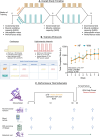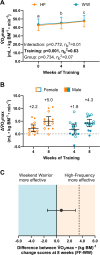Cardiorespiratory Fitness Improvements Following Low-Frequency Training Are Not Inferior to High-Frequency Training Matched for Intensity and Volume
- PMID: 39921357
- PMCID: PMC11806285
- DOI: 10.1111/sms.70024
Cardiorespiratory Fitness Improvements Following Low-Frequency Training Are Not Inferior to High-Frequency Training Matched for Intensity and Volume
Abstract
Epidemiological evidence suggests low-frequency physical activity provides health benefits, but the physiological impacts of weekly training frequency are understudied. We investigated whether "Weekend Warrior" (WW) training was inferior to traditional, high-frequency (HF) training for improving maximal oxygen uptake (V̇O2max). The secondary aim was to assess integrative physiological adaptations to each protocol. Twenty-eight sedentary-to-recreationally-active adults aged 18-45 years (14 males and 14 females) were randomized to perform 8-weeks of HF or WW training on a cycle ergometer (either four or two sessions weekly, respectively), consisting of continuous and interval exercise, with intensity and volume matched between groups. WW training was not inferior to HF training for improving V̇O2max (mean ± standard deviation; WW: 43.5 ± 6.5 vs. 47.8 ± 6.4 mL/kg/min; HF: 42.3 ± 6.2 vs. 47.3 ± 6.7; main effect of training, p < 0.001). Severe domain cycling time-to-task-failure also increased in both groups (WW: 3.7 ± 1.6 vs. 8.6 ± 3.2 min; HF: 3.5 ± 0.9 vs. 7.7 ± 2.8; main effect of training: p < 0.001). Frequency did not affect improvements in hemoglobin mass (WW: 771 ± 203 vs. 790 ± 189 g; HF: 754 ± 185 vs. 765 ± 202; main effect of training: p = 0.043) or skeletal muscle oxidative capacity (WW: 0.034 ± 0.008 vs. 0.045 ± 0.015 s-1; HF: 0.036 ± 0.011 vs. 0.041 ± 0.010; main effect of training: p = 0.002), nor did it influence improvements in cardiorespiratory, substrate oxidation, voluntary muscle contractile, and perceptual responses to submaximal exercise (interaction effect: p > 0.05 for all outcomes). Eight weeks of training improved V̇O2max and a wide range of physiological outcomes with no difference between training frequencies, suggesting that the distribution of weekly exercise volume has a limited effect during short-term training. Trial Registration: This trial was registered at ClinicalTrials.gov identifier: NCT05908578.
Keywords: V̇O2max; Weekend Warrior; exercise performance; exercise thresholds; fatigue; hemoglobin mass; muscle oxidative capacity; neuromuscular function.
© 2025 The Author(s). Scandinavian Journal of Medicine & Science In Sports published by John Wiley & Sons Ltd.
Conflict of interest statement
The authors declare no conflicts of interest.
Figures




References
-
- Egan B. and Sharples A. P., “Signal Transduction and Exercise,” in Molecular Exercise Physiology (Routledge, 2022), 152–189, 10.4324/9781315110752-7. - DOI
Publication types
MeSH terms
Associated data
Grants and funding
LinkOut - more resources
Full Text Sources
Medical
Research Materials
Miscellaneous

